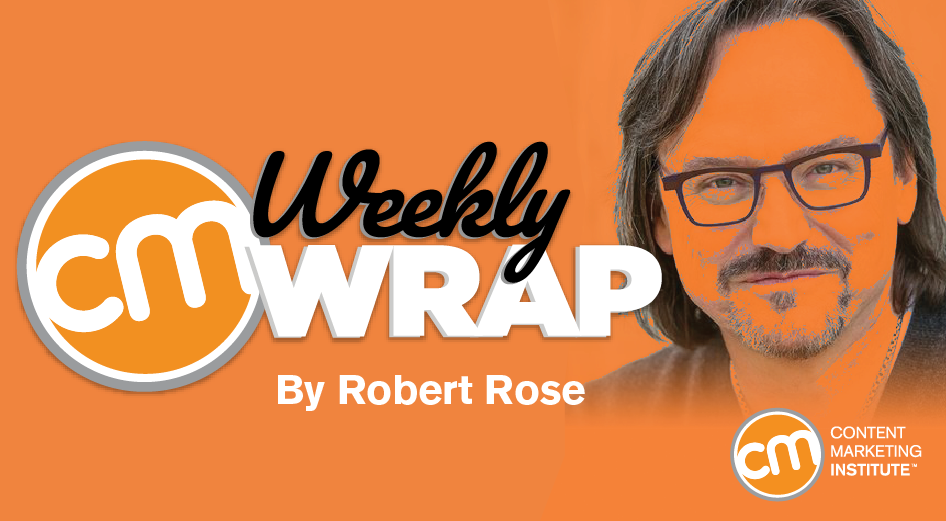 Listen to the Weekly Wrap here or subscribe on Apple Podcasts or Stitcher. If you enjoy the show, please take a moment to rate it or post a review.
Listen to the Weekly Wrap here or subscribe on Apple Podcasts or Stitcher. If you enjoy the show, please take a moment to rate it or post a review.
And that’s a wrap of the week ending May 22, 2020
This week I’m thinking about how we can never save time (so we should be careful how we spend it). I offer my fresh take on an article that claims the pandemic has created the biggest opportunity for publishing in 75 years. Jessica Hodkinson joins me to talk about the changes the COVID-19 crisis is bringing about in content marketing and strategy, and the differences in approach between B2B and B2C companies. Finally, I point to an article that asks whether we’re spending time on the right – or the wrong – things.
Listen to the Weekly Wrap
Our theme this week is time. (As Dr. Seuss wrote, “How did it get so late so soon?”) Let’s wrap it up.
One deep thought: The more you do, the less you do (3:23)
Time is precious. It’s not savable. Whatever time you spend, you don’t get back.
Time is precious. It’s not savable. Whatever time you spend, you don’t get back, says @robert_rose. #WeeklyWrap Click To TweetYour schedule is your budget. The time given to people or activities represents how much you value them.
Except, of course, it doesn’t.
If you listed how you spent your time over the last 24 hours, would it reflect the value you derive from those activities?
My most time-consuming activity today was cleaning out the garage and moving things to a storage facility. That’s definitely not what I value most.
Now, over weeks, months, and years, we may budget time with more of an eye toward personal value.
But perhaps we shouldn’t budget all of it.
Perhaps we shouldn’t budget all of our time, says @Robert_Rose via @cmicontent. #WeeklyWrap Click To TweetIn an interview, Bill Gates once talked about how billionaire Warren Buffett taught him a valuable lesson about time. The famed investor showed his calendar. Nothing was listed for weeks. And it changed the way the Microsoft founder thought. “There are all these demands and you feel like you need to go and see all these people,” he said. “It’s not a proxy of your seriousness that you fill every minute in your schedule.”
During a business disruption, it’s tempting to act quickly and schedule every moment in service of the changes we want to make. Last week, I spoke with a content leader who told me how the business she works for pivoted hard to creating content the last eight weeks. She and her team have been busier and more sought after than ever. She said yes to most requests, pushing herself and her team to the limit. And yet she’s finding every new Zoom meeting, task, and project less satisfying than the one before. She got exactly what she wanted, yet it felt like a Pyrrhic victory. Both she and the company were worse off for the efforts.
In this segment, I explore why it feels better to give someone your best because you have something valuable to offer rather than because you feel like you should do it. (Spoiler: When you lose sight of how valuable time is, you deplete your ability to spend quality time.)
A fresh take on running out of content (9:52)
An article in What’s New In Publishing called ‘The Biggest Opportunity … for Our Industry in 75 Years:’ Publishers Aren’t Taking the Pandemic Lying Down caught my eye this week.
The quote in the (lengthy) headline comes from FIPP President and CEO James Hewes in a report – Publishing During a Pandemic: Mapping a Path Through the COVID-19 Crisis.
What makes this strange time both an opportunity and a challenge for publishers, the article says, is that consumers are hungry for more content as stay-at-home precautions carry on, especially content that speaks to their passions.
The article cites a study by global media and marketing company Mindshare that found that 46% of American consumers surveyed said that by the end of April they had run out of media content to watch, read, or listen to. In mid-April, only 33% felt that way (and 20% at the end of March).
46% of U.S. consumers surveyed ran out of media content to consume by end of April, according to @mindshare_usa via @cmicontent. #research #WeeklyWrap Click To TweetIf that trend holds, we’ll run into the end of all content by the end of June. (Imagine me saying that with tongue firmly planted in cheek.)
No one is running out of content. But, anecdotally, a lot of people feel we are running low. I’ve seen so many social media posts about finishing Netflix, having seen #alltheshows, panicking over what to binge now, or desiring to read something that’s not about the top 10 album covers or how to make homemade sourdough bread.
People seem hungry for good content. Perhaps there is an opportunity. Listen to this fresh-take segment to hear what this all could mean for brands.
This week’s person making a difference in content: Jessica Hodkinson (16:29)
My guest this week is Jessica Hodkinson, a content strategist, writer, editor, and public relations professional who has worked with clients big and small, including Lenovo, Salesforce, LinkedIn, Robert Half, and others around the globe. Jessica and I talk about how B2B and B2C companies are weathering this crisis differently and the changes it’s bringing to content strategy and content marketing. Here’s a peek at one of Jessica’s observations:
#Engagement rates, especially on #social, have become more of the focus, says @jesshods via @cmicontent. #WeeklyWrap Click To TweetFor a few of my clients, engagement has been more of a focus. They like to see the numbers, but they also want to know that people are engaging, they’re finding the content useful. I’ve seen one client whose numbers have gone through the roof because they’re answering questions and answering them fast … (P)age views and time on site and all of those metrics are still valid, but I do think engagement rates, especially on social, have become more of the focus.
Listen in, then learn more about and from Jessica:
- Connect with her on LinkedIn or follow her on Twitter.
- Visit her website jessicahodkinson.com.
One content marketing idea you can use (32:27)
The CMI post I’d love for you to take another look at this week is by our own Ann Gynn, who got several speakers at Content Marketing World 2019 to identify the biggest time-wasters that plague content marketing programs. The unifying answer revolves around one thing – time. The team spends too much time on the wrong things, too little time on the helpful things, and no time on key things. This wonderful article is part therapy (we’re not alone), part discovery (oh, that’s what the problem is), and part help (OK, we can fix it). I hope you’ll check it out.
Love for our sponsor: Sitecore
Organizations all over the world are being forced to reevaluate their business plans and marketing strategies. The luxury of being able to take a leisurely approach to a digital transformation is no longer an option. Making human connections with customers in our suddenly digital-heavy world should be a top priority. And that means putting your digital transformation on the fast track. Recognized by analysts as a leader in digital experience platforms, Sitecore can help you create memorable customer experiences that build brand trust and loyalty. Learn more. 
The wrap-up
Join us again next week when I’ll share one deep thought that’s like a wristwatch dropped in salt water (it’s a timely solution). I’ll bring you one weekly news item (it’s not that strong). And I’ll offer one content marketing tip you can trade for clocks (you know, because time is money). And it’ll all be delivered in a little less time than it takes for Kim Kardashian’s line of face masks to sell out. If you have ideas for what you’d like to hear more of on our weekly play on words, let us know in the comments. And if you love the show, we’d sure love for you to review it or share it. Hashtag us up on Twitter: #WeeklyWrap.
How to subscribe

![]() Cover image by Joseph Kalinowski/Content Marketing Institute
Cover image by Joseph Kalinowski/Content Marketing Institute

